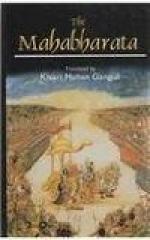135. The sense seems to be that these last three duties are productive of merit and should, therefore, be performed. The first three however, are sources of living.
136. Havishya is food cooked in a particular way and offered to the deities. It must be free from meat. There may be milk or ghee in it, but the cooking must be done in a single pot or vessel continuously; no change of vessels is allowed.
137. Vilwa is the Aegle marmelos, and Palasa is the Butea frondosa of Roxburgh.
138. At first he should live on fruits and roots and leaves, etc. Next on water, and then on air. There are different sects of forests recluses. The course of life is settled at the time of the initiatory rites.
139. What is stated here is this. The Sannyasin should not ask for alms: or, if he ever seeks for aims, he should seek them in a village or house where the cooking has been already done and where every one has already eaten. This limitation is provided as otherwise the Sannyasin may be fed to his fill by the householder who sees him.
140. He should never plunge into a stream or lake or tank for bathing.
141. Kalakankhi implies, probably ‘simply biding time’, i.e., allowing time to pass indifferently over him.
142. The sense seems to be this; the self or soul is without qualities. He who knows the self, or rather he who pursues the self with the desire of knowing it, should practise the truths of Piety laid down above. They constitute the path that leads to the self.
143. ‘That which has Brahman for its origin’ implies the Vedas.
144. Commentators differ about what is implied by the ten or the twelve. Nilakantha thinks that the ten mean the eight characteristics of Yoga, viz., Yama, Niyama, Asana, Pranayama, Pratyahara, Dharana, Dhyana, Samadhi, and Tarka and Vairagya. The twelve would imply the first eight, and these four, viz., Maitri, Karuna, Mudita, and Upeksha. If ten plus twelve or two and twenty be taken, then that number would be made up by the five modes of Yama, the five of Niyama, the remaining six of Yoga (beginning with Asana and ending with Samadhi), the four beginning with Maitri, and the two, viz., Tarka and Vairagya.
145. What is said in this Lesson seems to be this: the Unmanifest or Prakriti is that condition in which all the three qualities of Goodness, Passion, and Darkness exist in a state of combination. The unmanifest is the condition existing before creation. When one particular quality, viz., Goodness prevails over the others, there arises Purusha, viz., that from whom everything flows. The relation of Purusha and Nature is both unity and diversity. The three illustrations of the Gnat and the Udumbara the fish and water, and water drops and the lotus leaf, explain the relation between Purusha and Nature. He is in Nature, yet different from it. There is both association and dissociation.




